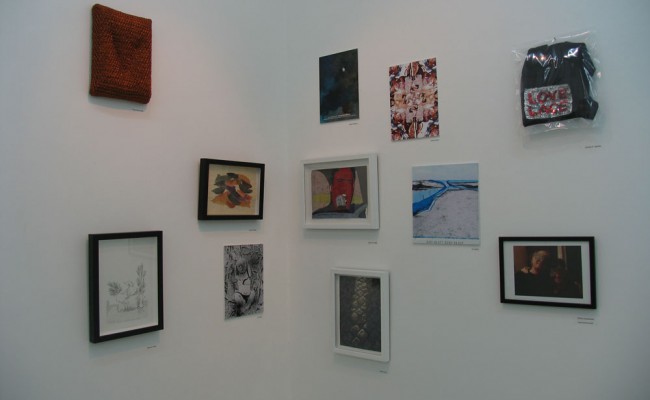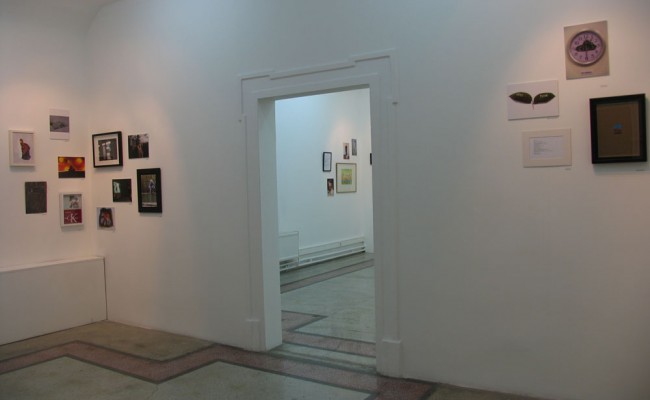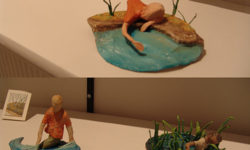Kasa Gallery of Sabanci University at Karaköy, is what its name implies. When you take the narrow stairs down to the vault, it is possible that you experience a slight claustrophobia. However, the feeling, as you enter the vault,, that you are about the share in or about to see something that no one else can see washes away the gloominess. And in fact, whenever I walked down to that vault, I did not have any regrets as I climbed up. Ahu Antmen, Turkish Art Almanac 2000 During the first years of its establishment, when the main campus at Tuzla was still under construction, Sabancı University started to search for a space which could house the academic staff and where meetings could be held. Minerva Han, a building located on the corner of Bankalar (Voyvoda) Street and Yüksek Kaldırım ramp, was used by Aksigorta as its headoffice for years, but left vacant as this firm moved to Fındıklı. In 1997, Güler Sabancı and the academic staff who were then working on the university project, made a visit to Minerva Han and decided to move in immediately. After a thorough renovation process, by March 1998 founding academic members of the university gradually started to move in to this historic building. The building with a round facade decorated with blue tiles and sculptural elements which looks on to Galata Bridge and Karaköy square, is thought to be commissioned by Bank of Athens to architect Basile Couremenos and built in years 1911-1913. This elegant building with perfect proportions which housed many local and international financial firms since then, is truly missed by everyone who worked there during the set up period of the university. The idea of converting the historic vault that is discovered at the basement of Minerva Han, into an art gallery is raised by Erdağ Aksel and Selim Birsel who were appointed to start the Visual Arts and Visual Communication Design program. With the approval and support of Güler Sabancı and Tosun Terzioğlu the project gets under way in 1999. As the campus started to operate and growing number of academic staff, brought forward a need for a Kasa Gallery commitee. Erdağ Aksel and Selim Birsel, with their interest in the subject and relationships with the art circles, were the members of it from the start and for different periods Lewis K.Johnson, Hasan Bülent Kahraman and Wieslaw Zaremba have also participated in the gallery commitee. As Minerva Han is appointed as the Sabancı University Communication Center, management of Kasa Gallery was first carried out by Kerimcan Güleryüz and later on by Selmin Kangal. Since 2005, Aslı Çetinkaya has been working as the gallery manager. Aksel and Birsel, two visual artists whose relationship with galleries until then was not beyond having their own shows at differents art spaces, perhaps thought Kasa Gallery to be a temporary project during its initiation and never imagined to organize a 10th year exhibition. Kasa Gallery was conceived as a space where artists would aspire to have their works shown at and the vision and working principles of the gallery were set accordingly. Considering the fact that the gallery is part of an educational institution, to build an art space which would prioritise young artists was set as one its main goals. However, being ‘young’ has never been the one and only measure of exhibiting and it is always kept in mind that in order for a gallery to provide a worthy opportunity for a young artist, that space has to have its own record of consistency and credibility. For this reason, putting a reasonable distance between itself and the education and production taking place at the university has always been a primary concern since ‘student works’ exhbitions would keep it down from achieving a reputation as an ‘independent’ contemporary art space with trustable artistic preferences and desicions Another gallery policy was not to have any exhibitions showcasing the works of members of the gallery commitee. In other words, the artists who conceived a space where they would be willing to have exhibitions, ironically started the gallery on a principle preventing them to do so. The first exhibition series of Kasa, ‘Winds into Future’ was organized through an organization brought forward with the help of Asuman Akyüz, currently the director of University Information Center, and young artists suggested by a wide group of artists and cultural agents were invited to apply for solo exhbitions to be held. Works of applicants were later evaluated by a group of referees. However, at this point, the founders of Kasa who were not experienced as galerists experinced their first serious problems; selections based on documents, project descriptions, photographs and portfolio presentations caused difficulties which might be characteristic to similar ‘competitions’. For instance, some selected projects which seemed exciting, turned out to be impossible to realize due to physical or economic constraints. Inevitably a ‘shortlist’ had to be created and presented to a second jury composed of academic staff and five artists to be exhibited in solo shows were finalised. On 7 April 1999, French origin, heavy iron cast door of Kasa Gallery opened for the first time with Şeyda Cesur’s show. Problems and hardships experienced from the start of this university gallery and innovative solutions proposed to those difficulties continue to be informative for the related academic people and the gallery managers. Quite different from what artists used to hear for many years from the galleries they work, - ‘you cannot nail on that wall’- at Kasa an artist and work oriented approach is embraced. Thereby, all the walls at Kasa were painted, drilled, hammered and plastered over and over again, and at the end of every show returned to its initial state by Mustafa Caymaz, who almost miraculously never stopped finding solutions to any technical problem during installations. Since 1999, Sabancı University is a member of BJCEM which organizes Biennial of Young Artists from Europe and Mediterrenean. Selections and arrangements regarding this connection are carried out by Kasa Gallery. After 1999 Biennial of Rome, works of artists selected and exhibited at Sarajevo (2001), Athens (2003), Naples (2005), Puglia (2007) and Skopje (2009) Biennials are also shown in Istanbul through ‘Winds into Future’ exhibitions. Artists to participate at the biennials are selected by referee commitees composed of artists, academicians and galerists. For most of the participants, this important international event provided the opportunity of exhibiting abroad for the first time. Bienial of young artists not only enabled the artists establish artistic and personal connections but also many of them were invited to residencies and exhibitions following the event. If for a moment, we were to put aside the modest attitude that Kasa Gallery typically adopts, it could be asserted that paths of many artists who are active and well known in local and international art scenes have coincided with Kasa and BJCEM biennials. From 1999 until December 2002, when Karakoy communication center had to struggle the flooding problem and Kasa had to stop operating, 48 artists exhibited in 26 shows. The gallery restarted exhibiting in October 2004 and by the end of 2009, in its 10th year, number of shows and artists exhibited reached 51 and 139 respectively. For the sake of continuity of exhibitions through out the years, annual exhibition series as a programing form was decided upon by the academic gallery commitee in 2000. Taking both the academic calendar and Istanbul’s current art schedule into account, certain recurrent exhibition series with specific titles and different focus fields were proposed. Getting more experienced in organising and exhibiting, and with the changes in contemporary art and artistic production, those titles were interpreted more flexibly and exhibition series program gradually left behind. This shift has made Kasa exhibitions more dynamic, and the support of invited curators and the conceptual frames they brought along developed it further. In her above quoted article about 1999-2000 ‘The Beginings: Different Approaches in Drawing’ exhibitions, Antmen further asks a question; ‘Would not it be nice if Kasa Gallery could publish catalogues compiling the annual exhibitions which are presented under one single theme, I do not know if they have such a plan or not?’ .Catalogues for exhibition series did not come out and annual recurrent exhibition program did not continue, however for its 10th anniversary Kasa went on to publish a book and organise an exhibition. With this project, in which 139 artists were invited to contribute with a ‘new’ – different than their works exhibited here previously- standard A4 office paper size work, while keeping that characteristic feeling of curiosity alive, we also wished to have a collection of works giving hints about their latest artistic involvements or ongoing interests and priorities. For the artists who sadly passed away in the last ten years, Hüseyin B. Alptekin, Mehmet Koyunoğlu and Mutlu Çerkez, in order to commemorate such significant artistic production and their honorable existence at Kasa, we used the materials we had and those we could find for the book and exhibition. Instead of leaving out the names of artists who could not or did not participate in the project, we prefered to include in the book some images form their previous shows at the gallery. In the section ‘Texts’, we brought together the exhibition texts we had in our archive, written by the curators or artists of those exhibitions. The gallery, consisting of three successive rooms but with a plan which does not obstruct the sense of continuity in viewing, with the expectations and even tension advanced by the narrow stairway and with the implications of its earlier use as a vault, has a spatial dominance which is sometimes difficult to get over and which cannot be neutralized by its white walls. Hence, a number of artists have produced exhibitions or works originating from these characteristic components of the space. The comment, quoted at the very begining of this introduction, was forwarded for an art space at its very early years. Hopefully in the past 10 years, that happened to be the case for most of the artists and visitors; those who went down to the vault did not come up regreting it. Selim Birsel, Aslı Çetinkaya, Erdağ Aksel




